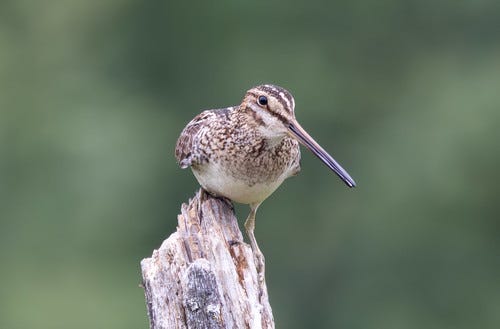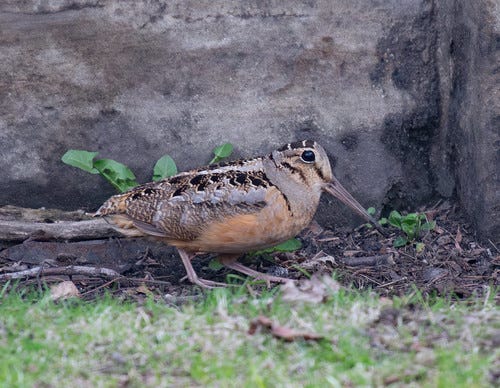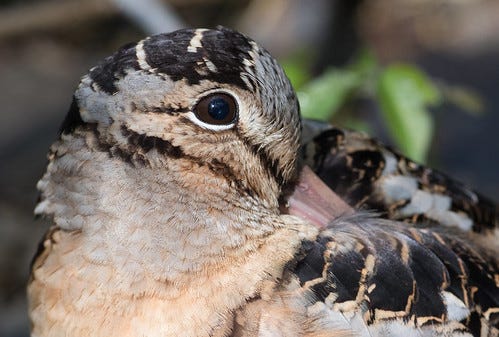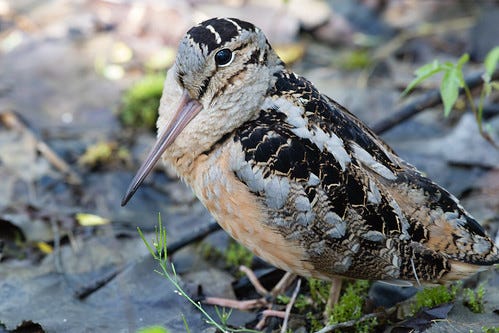(Listen to the radio version here.)
On Thursday, I took my grandson Walter to the Lake Superior Railroad Museum. We had a jolly time, and when we got home and I pulled into my very short driveway, what to my wondering eyes should appear but a plump little woodcock flying up from where it had apparently been feeding or resting under the spruce tree next to my driveway on my right; now it landed in a patch of bare grass under the spruce tree in the front yard to my left, as close as I’ve ever seen a woodcock out in the open before.
The train museum is singularly devoid of birds, so I had neither my binoculars nor my long-lens camera. It didn’t matter—the immediate task was to show the bird to Walter. Unfortunately, he was securely strapped in his car seat in back on the far side of the vehicle with no angle to see the bird until it took off, but he at least got a glimpse of it flying away.
As soon as we got into the house and Walter got busy with Legos, I rushed out with my camera, but I couldn’t find it. I wasn’t as disappointed as one might expect—the look I got at such close range is one of the best looks I’ve ever had of a woodcock, even through binoculars. I may not have a photo, but the image is etched into my mind’s eye.
Woodcocks look a lot like chunky Wilson’s Snipes only with shorter legs and necks, unbarred sides and flanks, and head striping that runs side-to-side instead of front-to-back.


Both the woodcock and snipe have an exceptionally long bill used to probe for worms and other subterranean invertebrates, and that bill, for both, is “prehensile”—that is, the tip can open while the rest of the bill stays closed. The birds can insert the bill almost 3 inches into wet, mucky, compacted soil and then just open the tip to grab a worm.
(I made the above 1-minute video of a woodcock feeding in 2018 at the Magee Marsh during the Biggest Week in American Birding (which I HIGHLY recommend). The video goes slightly out of focus briefly, but you can watch the bird feed pretty well.)
Anyone living near where woodcocks display can’t help but notice them, which is why they have so many colorful nicknames, such as timberdoodles, Labrador twisters, night partridge, and bog suckers.
And now my 4 ½ year old grandchild is aware of yet another splendid creature with whom we share this planet—a creature that I had no clue existed until I was 23, when I pored through my first field guide. Peterson’s depiction of the squat, round, short-legged little guy with the improbably long bill caught my eye.
That same year, I read Aldo Leopold’s A Sand County Almanac in an environmental education class taught by the wonderful Bob Hinkle, a man I’m honored to call my friend. Bob’s voice is ever soft, gentle, and low—an excellent thing in an inspirational instructor. He read aloud a few of his favorite passages, including the section called “Sky Dance” in the April chapter. Aldo Leopold’s words spoken in Bob Hinkle’s voice made me yearn with all my heart to see a woodcock dancing in the sunset sky.
And the very next spring I did! And just like Leopold, oddly enough, I got to enjoy the ethereal vision in my own backyard. Russ and I were spending our last two terms at Michigan State housesitting for a professor while he was on sabbatical. A large tract of undeveloped land behind his house gave me several lifers, but none as memorable as the woodcocks. Sitting out on the patio I could hear their vocal peents, their twittering wings as they spiraled up into the sky and circled above, and starting at the top, what Leopold called their “soft liquid warble that a March bluebird might envy.”
Sometimes when a nearby woodcock rose, I’d walk closer to where he’d taken off and crouch down, holding perfectly still. A few times I ended up right where I could see him land and watch him peenting. At such close range, I could also hear the little hiccups or gulping sounds between peents. Until mosquitoes drove me inside, I’d stay put as time after time, he spiraled up, circled, and dropped like a falling leaf to the exact same spot on the ground. How I loved those spring evenings!
The woodcocks had stopped displaying for the year by early June when we packed up our belongings and moved to Madison, Wisconsin. After that, every spring I made it a point to go to at least one place to see their displays, but it wasn’t the same as sitting in my own backyard entranced in the twilight.
Russ’s parents retired to Port Wing, Wisconsin, in 1979. We visited them there several times, but it wasn’t until we moved to Duluth in 1981 that I was ever at their place in April and early May. Imagine my joy to discover that woodcocks displayed right in their front yard! When I got good sound recording equipment in 2001, one of my very first recordings was of a woodcock peenting right next to their driveway. My mother-in-law moved in with us in 2012, and the house was sold a few years later. But listening to this recording always carries my heart and soul back to Kinney Valley Road in Port Wing.
Until Thursday, I’d never actually seen an American Woodcock in my own yard here in Duluth, though it’s been on my yard list since 2001. Back then, before too much development destroyed the remaining habitat by the railroad tracks along Superior Street a few blocks away, one or two woodcocks were still displaying each spring. So one evening I sat on our roof with my parabola pointed toward them, and voila! I figure if we’re allowed to count birds we magnify visually with binoculars and spotting scopes, why shouldn’t we magnify them aurally with a parabola?
A few years ago, I spotted one in the woodsy area behind our house. I count a bird for my yard list if either the bird or I am touching something on my property, so as long as I could see it from my side of my back fence, it counted.
This time around, seeing the bird right there on my lawn didn’t put it on any special lists (well, now it’s on my year list), but this Peabody Street encounter was more meaningful than the previous two. I always say no one should go through life listlessly, but really, lists are nothing more than rudimentary outlines of real-life experiences with birds. And the memory of my real-life experience with that little woodcock, momentary as it was, will warm my heart as long as I live.









I had a similar experience at least 10 years ago. I drove an elderly friend of mine who was also a birder, to hear a speaker I don't even remember who we were heard that rainy night. When I pulled into her driveway, there in the headlights was an American Woodcock, hunkered down next to some bushes. We must have watched that bird for 20 minutes. Great memories!
I forwarded this blurb to my hubby's computer and he loved it and hopes yet to see the dance (me too!)!